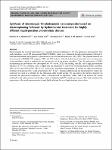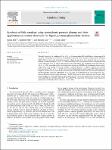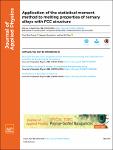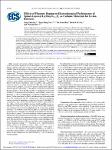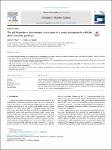Search
Author
- Quan-Hoang Vuong (27)
- Anh-Tuan Le (17)
- Vuong QH (12)
- Anh D. Phan (11)
- next >
Subject
- Electrospinning (8)
- Nanoparticles (6)
- Compound droplet (5)
- Machine learning (5)
- next >
Date issued
- 2020 - 2022 (482)
- 2010 - 2019 (19)
- 2002 - 2009 (1)
Has File(s)
Search Results
Heterostructure alloys with controlled structure and composition are essential for future electronics and optoelectronics. While heterostructure formation creates sharp electronic junction, alloying allows bandgap tunability. Herein, ZnS/ZnO heterostructure-alloy hexagonal micropyramids are grown on Si/SiO2 wafers for the first time by facile thermal evaporation of ZnS powder. It is found that the pyramids with a based size of few micrometers are grown along different crystallographic directions and neighbored by ZnS microrods. XRD and XPS spectra showed that ZnS, ZnO, and ZnSO wurtzite phases coexist in the as-received samples. FESEM images, in situ point, and EDS elemental mapping spectra reveal that the micropyramids are composed of Zn, S, O, but each element's ratio changes with... |
The rational design of nanomaterials for electrochemical nanosensors from the perspective of structure–property–performance relationships is a key factor in improving the analytical performance toward residual antibiotics in food. We have investigated the effects of the crystalline phase and copper loading amount on the detection performance of Cu–MoS2 nanocomposite-based electrochemical sensors for the antibiotic chloramphenicol (CAP). The phase composition and copper loading amount on the MoS2 nanosheets can be controlled using a facile electrochemical method. Cu and Cu2O nanoparticle-based electrochemical sensors showed a higher CAP electrochemical sensing performance as compared to CuO nanoparticles due to their higher electrocatalytic activity and conductivity. Moreover, the de... |
In this paper, we propose an extension of the Ricci-inverse gravity, which has been proposed recently as a very novel type of fourth-order gravity, by introducing a second order term of the so-called anticurvature scalar as a correction. The main purpose of this paper is that we would like to see whether the extended Ricci-inverse gravity model admits the homogeneous and isotropic Friedmann–Lemaitre–Robertson–Walker metric as its stable inflationary solution. However, a no-go theorem for inflation in this extended Ricci-inverse gravity is shown to appear through a stability analysis based on the dynamical system method. As a result, this no-go theorem implies that it is impossible to have such stable inflation in this extended Ricci-inverse gravity model |
Open access (OA) publishing is beneficial for researchers to improve recognition, representation, and visibility in academia. However, few studies have been conducted for studying the association between gender and OA publishing likelihood. Therefore, the current study explores the impacts of gender-based authorship structures on OA publishing in Vietnamese social sciences and humanities. Bayesian analysis was performed on a dataset of 3122 publications in social sciences and humanities. We found that publications with mixed-gender authorship were most likely to be published under Gold Access terms (26.31–31.65%). In contrast, the likelihood of publications with the solely male or female author(s) was lower. It is also notable that if female researcher(s) held the first-author posit... |


